Structural and Optical Properties of BaWO4 Obtained by Fast Mechanochemical Treatment
Abstract
1. Introduction
2. Results
2.1. Phase Formation of BaWO4 with an Applied Milling Speed of 850 rpm
2.1.1. X-Ray Diffraction Analysis
2.1.2. Vibrational Spectroscopy
2.1.3. SEM Analysis
2.2. Optical Properties
2.2.1. UV–Vis Diffuse Reflectance Spectroscopy
2.2.2. Photoluminescence Emission Spectroscopy
3. Discussion
4. Materials and Methods
5. Conclusions
Author Contributions
Funding
Institutional Review Board Statement
Informed Consent Statement
Data Availability Statement
Acknowledgments
Conflicts of Interest
References
- Vidya, S.; Solomon, S.; Thomas, J.K. Synthesis, Characterization, and Low Temperature Sintering of Nanostructured BaWO4 for Optical and LTCC Applications. Adv. Conden. Matter Phys. 2013, 1–2, 409620–409631. [Google Scholar]
- Cheng, L.; Liu, P.; Qu, S.X.; Zhang, H.W. Microwave dielectric properties of AWO4 (A = Ca, Ba, Sr) ceramics synthesized via high energy ball milling method. J. Alloys Compd. 2013, 581, 553–557. [Google Scholar] [CrossRef]
- Guia, L.; Yanga, H.; Zhao, Q.; Li, E. Synthesis of low temperature firing scheelite-type BaWO4 microwave dielectric ceramics with high performances. Ceram. Int. 2018, 46, 1360–1365. [Google Scholar] [CrossRef]
- Ren, Y.; Wang, J.; Guo, Y.; Li, D.; Li, J. Sintering behavior, lattice vibrational characteristics and dielectric properties of B-site ion substituted BaWO4 ceramics for LTCC applications. J. Alloys Compd. 2025, 1010, 177261–177273. [Google Scholar] [CrossRef]
- Hemmati, M.; Tafreshi, M.J.; Ehsani, M.H.; Alamdari, S. Highly sensitive and wide-range flexible sensor based on hybrid BaWO4 @CS nanocomposite. Ceram. Int. 2022, 48, 26508–26518. [Google Scholar] [CrossRef]
- Sulc, J.; Jelınkova, H.; Basiev, T.T.; Doroschenko, M.E.; Ivleva, L.I.; Osiko, V.V.; Zverev, P.G. Nd: SrWO4 and Nd:BaWO4 Raman lasers. Opt. Mater. 2007, 30, 195–197. [Google Scholar] [CrossRef]
- Kinyaevskiy, I.O.; Koribut, A.V.; Seleznev, L.V.; Grudtsyn, Y.V. Stimulated Raman scattering of titanium-sapphire laser pulses with duration from 7 ps to 45ps in BaWO4 crysral. Opt. Spectrosc. 2024, 132, 49–52. [Google Scholar]
- Zhou, G.; Lu, M.; Xiu, Z.; Wang, S.; Zhang, H.; Zou, W. Polymer micelle-assisted fabrication of hollow BaWO4 nanospheres. J. Cryst. Growth 2005, 276, 116–120. [Google Scholar] [CrossRef]
- Lima, R.C.; Anicete-Santos, M.; Orhan, E.; Maurera, M.A.M.A.; Souza, A.G.; Pizani, P.S.; Leite, E.R.; Varela, J.A.; Longo, E. Photoluminescent property of mechanically milled BaWO4 powder. J. Lumin. 2007, 126, 741–746. [Google Scholar] [CrossRef]
- Tyagi, M.; Sabharwal, S.S.C. Luminescence properties of BaWO4 single crystal. J. Lumin. 2008, 128, 1528–1532. [Google Scholar] [CrossRef]
- Thongtema, T.; Phuruangrat, A.; Thongtem, S. Characterization of MeWO4 (Me = Ba, Sr and Ca) nanocrystallines prepared by sonochemical method. Appl. Surf. Sci. 2008, 254, 7581–7585. [Google Scholar] [CrossRef]
- Cavalcante, L.S.; Sczancoski, J.C.; Lima, L.F.; Espinosa, J.W.M.; Pizani, P.S.; Varela, J.A.; Longo, E. Synthesis, Characteri-zation, Anisotropic Growth and Photoluminescence of BaWO4. Cryst. Growth Des. 2009, 9, 1002–1012. [Google Scholar] [CrossRef]
- Cavalcante, L.S.; Sczancoski, J.C.; Espinosa, J.W.M.; Varela, J.A.; Pizani, P.S.; Longo, E. Photoluminescent behavior of BaWO4 powders processed in microwave-hydrothermal. J. Alloys Coumpd. 2009, 474, 195–200. [Google Scholar] [CrossRef]
- Yin, Y.; Gan, Z.; Sun, Y.; Zhou, B.; Zhang, X.; Zhang, D.; Gao, P. Controlled synthesis and photoluminescence properties of BaXO4 (X = W, Mo) hierarchical nanostructures via a facile solution route. Mater. Lett. 2010, 64, 789–792. [Google Scholar] [CrossRef]
- Shen, Y.; Li, W.; Li, T. Microwave-assisted synthesis of BaWO4 nanoparticles and its photoluminescence properties. Mater. Lett. 2011, 65, 2956–2958. [Google Scholar] [CrossRef]
- Lim, C.S. Solid-state metathetic synthesis of BaMO4 (M = W, Mo) assisted by microwave irradiation. J. Ceram. Proc. Res. 2011, 12, 544–548. [Google Scholar]
- Cavalcante, L.S.; Batista, F.M.C.; Almeida, M.A.P.; Rabelo, A.C.; Nogueira, I.C.; Batista, N.C.; Varela, J.A.; Santos, M.R.M.C.; Longo, E.; Li, M.S. Structural refinement, growth process, photoluminescence and photocatalytic properties of (Ba1-xPr2x/3)WO4 crystals synthesized by the coprecipitation method. RSC Adv. 2012, 2, 6438–6454. [Google Scholar] [CrossRef]
- Zawawi, S.M.M.; Yahya, R.; Hassan, A.; Mahmud, H.N.M.E.; Daud, M.N. Structural and optical characterization of metal tungstates (MWO4; M=Ni, Ba, Bi) synthesized by a sucrose-templated method. Chem. Cent. J. 2013, 7, 80–90. [Google Scholar] [CrossRef]
- Sadiq, M.M.J.; Nesaraj, A.S. Soft chemical synthesis and characterization of BaWO4 nanoparticles for photocatalytic removal of Rhodamine B present in water sample. J. Nanostruct. Chem. 2015, 5, 45–54. [Google Scholar] [CrossRef]
- Shivakumara, C.; Saraf, R.; Behera, S.; Dhananjaya, N.; Nagabhushana, H. Scheelite-type MWO4 (M = Ca, Sr, and Ba) nanophosphors: Facile synthesis, structural characterization, photoluminescence, and photocatalytic properties. Mater. Res. Bull. 2015, 61, 422–432. [Google Scholar] [CrossRef]
- Mesquita, F.A.; Feitosa, C.A.C.; Balzer, R.; Probst, L.F.D.; Batalha, D.C.; Rosmaninho, M.G.; Fajardo, H.V.; Bernardi, M.I.B. Preparation, characterization and catalytic application of Barium molybdate (BaMoO4) and Barium tungstate (BaWO4) in the gas-phase oxidation of toluene. Ceram. Int. 2017, 43, 4462–4469. [Google Scholar]
- Sivaganesh, D.; Saravanakumar, S.; Ali, K.S.S.; Alshehri, A.M. Effect of preparation techniques on BaWO4: Structural, morphological, optical and electron density distribution analysis. J. Mater. Sci. Mater. Electron. 2021, 32, 1466–1475. [Google Scholar] [CrossRef]
- Kowalkinska, M.; Głuchowski, P.; Swebocki, T.; Ossowski, T.; Ostrowski, A.; Bednarski, W.; Karczewski, J.; Zielinska-Jurek, A. Scheelite-Type Wide-Band gap ABO4 Compounds (A = Ca, Sr, and Ba; B = Mo and W) as Potential Photocatalysts for Water Treatment. J. Phys. Chem. C 2021, 125, 25497–25513. [Google Scholar] [CrossRef]
- Liao, J.; Qiu, B.; Wen, H.; You, W.; Xiao, Y. Synthesis and optimum luminescence of monodispersed spheres for BaWO4-based green phosphors with doping of Tb3+. J. Lumin. 2010, 130, 762–766. [Google Scholar] [CrossRef]
- Jia, G.; Dong, D.; Song, C.; Li, L.; Huang, C.; Zhang, C. Hydrothermal synthesis and luminescence properties of monodisperse BaWO4: Eu3 submicrospheres. Mater. Lett. 2014, 129, 251–254. [Google Scholar] [CrossRef]
- Bouzidi, C.; Ferhi, M.; Elhouichet, H.; Ferid, M. Spectroscopic properties of rare-earth (Eu3, Sm3) doped BaWO4 powders. J. Lumin. 2015, 161, 448–455. [Google Scholar] [CrossRef]
- Jena, P.; Gupta, S.K.; Verma, N.K.; Singh, A.K.; Kadam, R.M. Energy transfer dynamics and time resolved photolumines-cence in BaWO4: Eu3+ nanophosphors synthesized by mechanical activation. New J. Chem. 2017, 41, 8947–8958. [Google Scholar] [CrossRef]
- Carvalho, I.P.; Sousa, R.B.; Matos, J.M.E.; Moura, J.V.B.; Freire, P.T.C.; Pinheiro, G.S.; Luz-Lima, C. Low-temperature induced phase transitions in BaWO4: Er3 + microcrystas: A Raman scattering study. J. Mol. Struct. 2020, 1204, 127497–127498. [Google Scholar] [CrossRef]
- Jung, J.; Kim, J.; Shim, Y.S.; Hwang, D.; Son, C.S. Structure and Photoluminescence Properties of Rare-Earth (Dy3+, Tb3+, Sm3+)-Doped BaWO4 Phosphors Synthesized via Co-Precipitation for Anti-Counterfeiting. Materials 2020, 13, 4165–4177. [Google Scholar] [CrossRef]
- Gopal, R.; Manam, J. The photoluminescence and Judd-Ofelt investigations of UV, near-UV and blue excited highly pure red emitting BaWO4: Eu3+ phosphor for solid state lighting. Ceram. Int. 2023, 49, 28118–28129. [Google Scholar] [CrossRef]
- Paikray, X.S.; Ray, S.K.; Nayak, P.; Sahoo, A.K.; Prusty, S.N.; Dash, S.; Nanda, S.S. Comparative analysis of Sm3+-doped BaWO4 and CaWO4 phosphors: Properties and application in latent fingerprints and anti-counterfeiting. J. Alloys Compd. 2025, 1010, 177666–177676. [Google Scholar] [CrossRef]
- Shana, Z.; Wang, Y.; Ding, H.; Huang, F. Structure-dependent photocatalytic activities of MWO4 (M = Ca, Sr, Ba). J. Mol. Catal. A Chem. 2009, 302, 54–58. [Google Scholar] [CrossRef]
- Sridhar, C.; Seo, Y.S.; Rabani, I.; Turpu, G.R.; Tigga, S.; Padmaja, G. Electrochemical, Photocatalytic and Photolumines-cence properties of BaWO4 and rGO-BaWO4 nano-composites: A Comparative study. Curr. Appl. Phys. 2024, 58, 79–90. [Google Scholar] [CrossRef]
- Jafar, M.; Kumar, A.; Gupta, V.G.; Tyagi, A.K.; Bhattacharyya, K. Scheelite Catalysts for Thermal Mineralization of Toluene: A Mechanistic Overview. ACS Omega 2025, 10, 13080–13104. [Google Scholar] [CrossRef]
- Sleight, A.W. Accurate Cell Dimensions for ABO4 Molybdates and Tungstates. Acta Cryst. B 1972, 28, 2899–2902. [Google Scholar] [CrossRef]
- Gancheva, M.; Iordanova, R.; Avdeev, G.; Ivanov, P. Direct mechanochemical synthesis and optical properties of BaWO4 nanoparticles. Bulg. Chem. Commun. 2022, 54, 41–46. [Google Scholar]
- Gancheva, M.; Iordanova, R.; Koseva, I.; Avdeev, G.; Burdina, G.; Ivanov, P. Synthesis and Luminescent Properties of Barium Molybdate Nanoparticles. Materials 2023, 16, 7025–7706. [Google Scholar] [CrossRef]
- Iordanova, R.; Gancheva, M.; Koseva, I.; Tzvetkov, P.; Ivanov, P. The Influence of High-Energy Milling on the Phase Formation, Structural, and Photoluminescent Properties of CaWO4 Nanoparticles. Materials 2024, 17, 3724–3738. [Google Scholar] [CrossRef]
- Gancheva, M.; Iordanova, R.; Avdeev, G.; Piroeva, I.; Ivanov, P. Direct mechanochemical synthesis of SrMoO4: Structural and luminescence properties. RSC Mechanochem. 2025, 2, 459–467. [Google Scholar] [CrossRef]
- Jablan, Z.J.; Marguí, E.; Posavec, L.; Klaric, D.; Cincic, D.; Galic, N.; Jug, M. Product contamination during mechanochemical synthesis of praziquantel co-crystal, polymeric dispersion and cyclodextrin complex. J. Pharm. Biomed. Anal. 2024, 238, 115855–115865. [Google Scholar] [CrossRef]
- Porto, S.P.S.; Scott, J.F. Raman Spectra of CaWO, SrWO4, CaMoO4, and SrMoO4. Phys. Rev. 1967, 157, 716–719. [Google Scholar] [CrossRef]
- Suda, J.; Kusama, A.; Sato, T. The First-Order Raman Spectra and Lattice Dynamics for sintered body-centered tetragonal BaWO4 Crystallinite. J. Spectrosc. Soc. Jpn. 2001, 50, 65–70. [Google Scholar] [CrossRef]
- Miller, P.J.; Khanna, R.K.; Lippincott, E.R. Studies of coupled molybdate and tungstate vibrations. J. Phys. Chem. Solids 1973, 34, 533–540. [Google Scholar] [CrossRef]
- Marquesa, A.P.A.J.; Meloa, D.M.A.; Longo, E.; Paskocimasa, C.A.; Pizanic, P.S.; Leite, E.R. Photoluminescence properties of BaMoO4 amorphous thin films. J. Solid State Chem. 2005, 178, 2346–2353. [Google Scholar] [CrossRef]
- Tauc, J. Absorption edge and internal electric fields in amorphous semiconductors. Mater. Res. Bull. 1970, 5, 721–729. [Google Scholar] [CrossRef]
- Huang, Y.; Guo, Z.; Liu, H.; Zhang, S.; Wang, P.; Lu, Y.; Tong, Y. Heterojunction Architecture of N-Doped WO3 Nanobundles with Ce2S3 Nanodots Hybridized on a Carbon Textile Enables a Highly Efficient Flexible Photocatalyst. Adv. Funct. Mater. 2019, 29, 1903490–1903499. [Google Scholar] [CrossRef]
- Li, Z.; Sun, H.; Xie, Z.; Zhao, Y.; Lu, M. Modulation of the photoluminescence of SrTiO3(001) by means of fluorhydric acid etching combined with Ar+ ion bombardment. Nanotechnology 2007, 18, 165703–165708. [Google Scholar] [CrossRef]
- Kunti, A.K.; Sekhar, K.C.; Pereira, M.; Gomes, M.J.M.; Sharma, S.K. Oxygen partial pressure induced effects on the micro-structure and the luminescence properties of pulsed laser deposited TiO2 thin films. AIP Adv. 2017, 7, 015021–015030. [Google Scholar] [CrossRef]
- Gupta, S.K.; Sudarshan, K.; Srivastava, A.P.; Kadam, R.M. Visible light emission from bulk and nano SrWO4: Possible role of defects in photoluminescence. J. Lumin. 2017, 192, 1220–1226. [Google Scholar] [CrossRef]
- Shinde, K.P.; Pawar, R.C.; Sinha, B.B.; Kim, H.S.; Oh, S.S.; Chung, K.C. Study of effect of planetary ball milling on ZnO na-nopowder synthesized by co-precipitation. J. Alloys Compnd. 2014, 617, 404. [Google Scholar] [CrossRef]
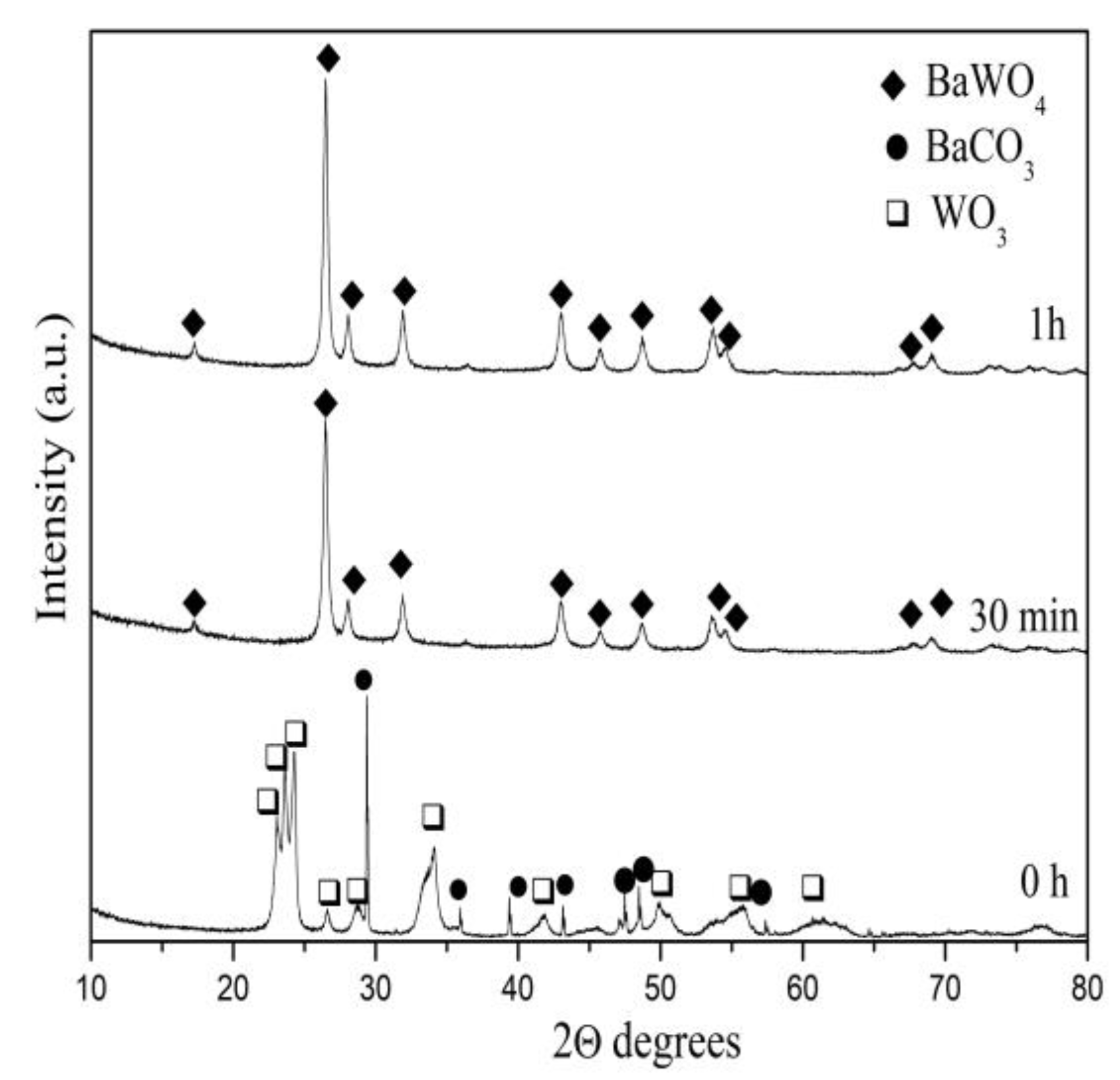
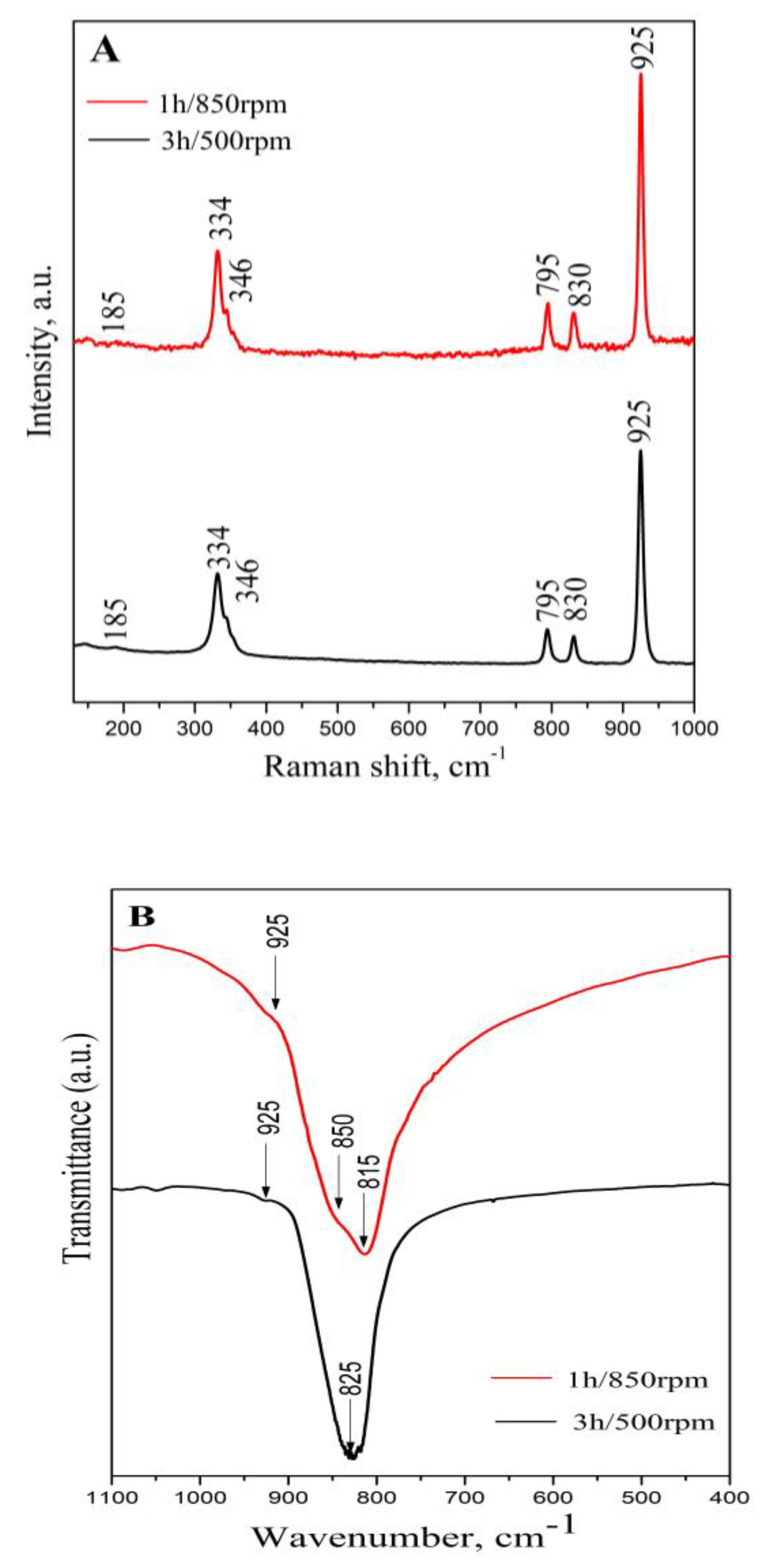
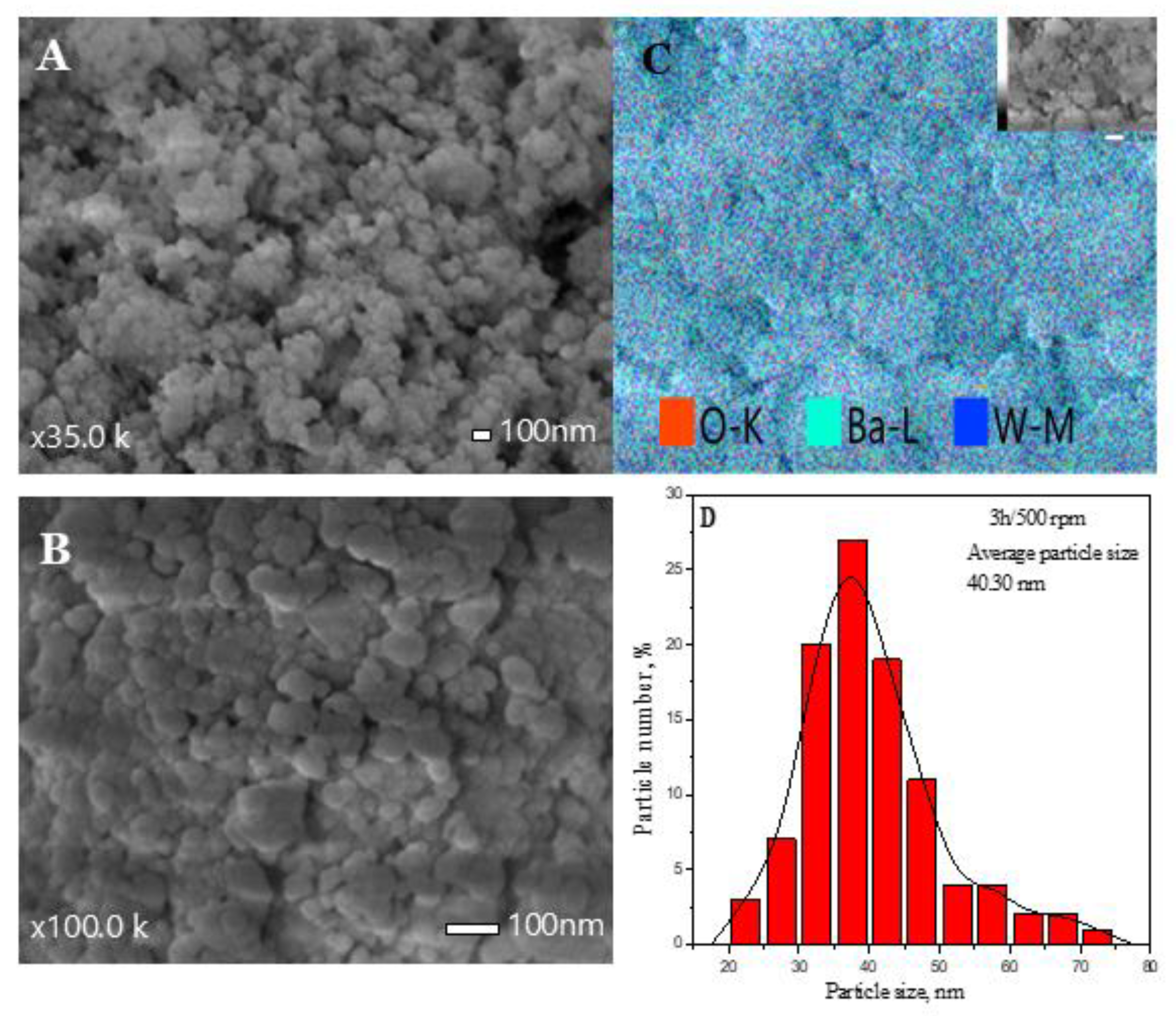

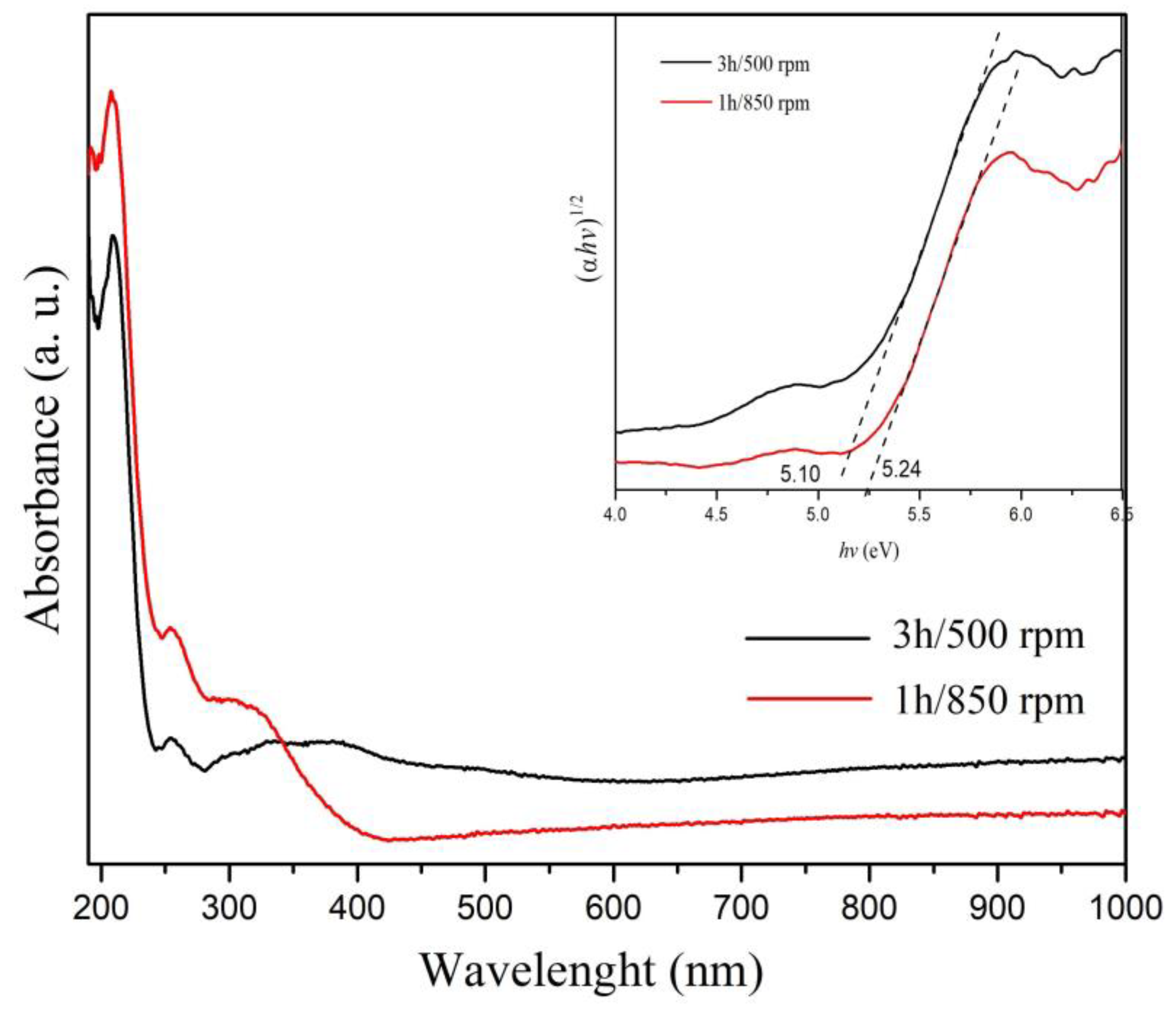
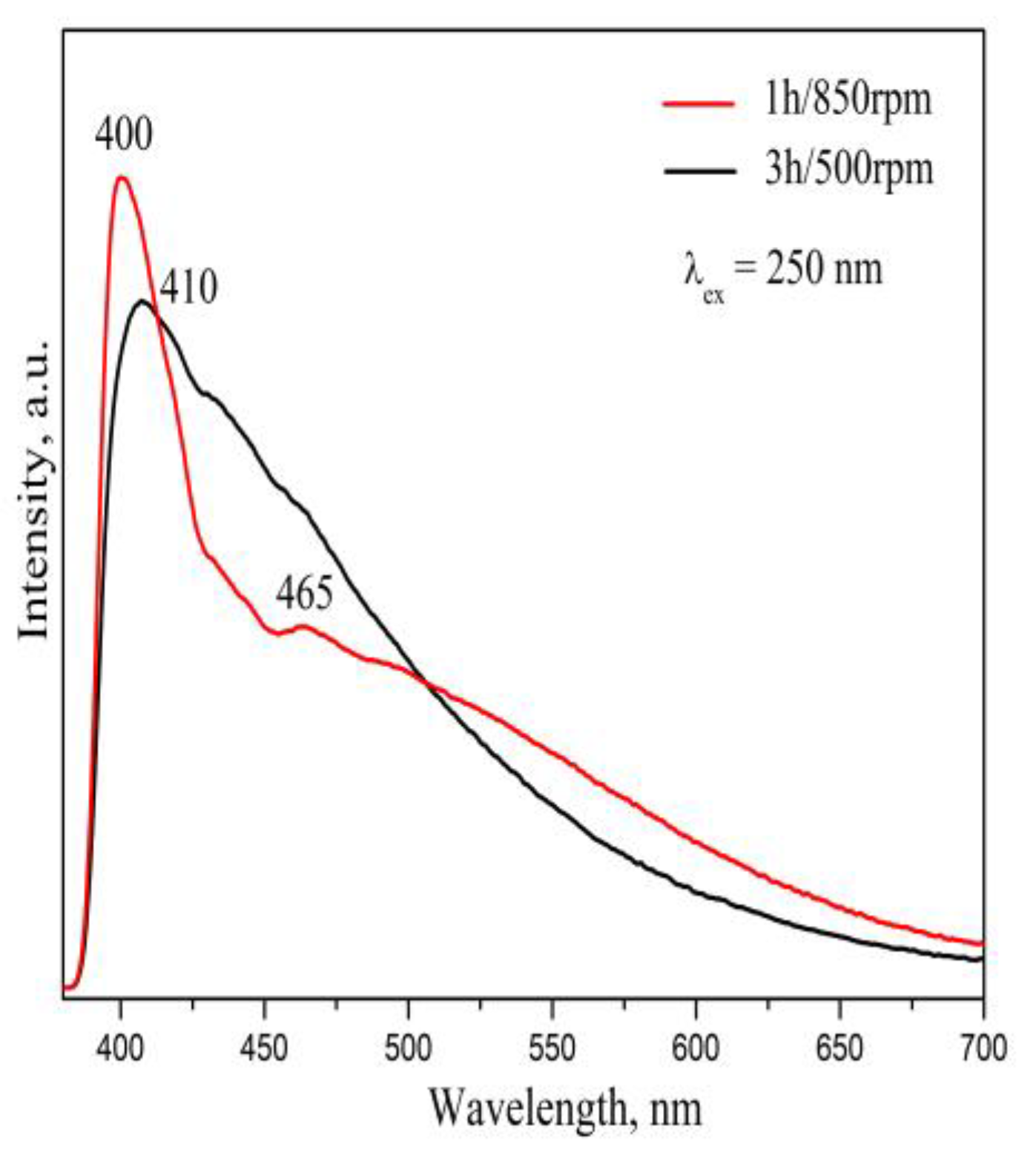
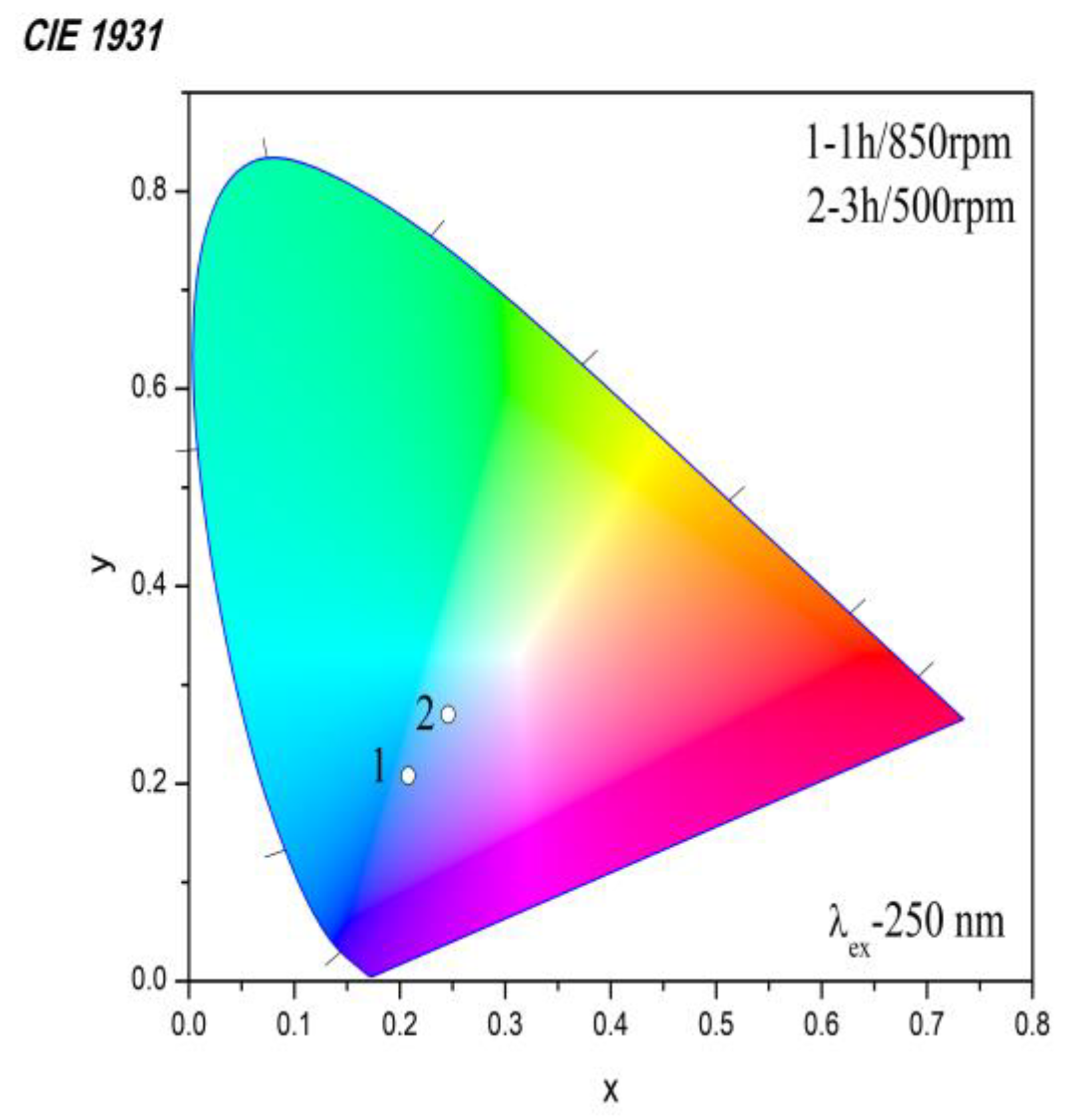
Disclaimer/Publisher’s Note: The statements, opinions and data contained in all publications are solely those of the individual author(s) and contributor(s) and not of MDPI and/or the editor(s). MDPI and/or the editor(s) disclaim responsibility for any injury to people or property resulting from any ideas, methods, instructions or products referred to in the content. |
© 2025 by the authors. Licensee MDPI, Basel, Switzerland. This article is an open access article distributed under the terms and conditions of the Creative Commons Attribution (CC BY) license (https://creativecommons.org/licenses/by/4.0/).
Share and Cite
Gancheva, M.; Iordanova, R.; Koseva, I.; Piroeva, I.; Ivanov, P. Structural and Optical Properties of BaWO4 Obtained by Fast Mechanochemical Treatment. Inorganics 2025, 13, 172. https://doi.org/10.3390/inorganics13050172
Gancheva M, Iordanova R, Koseva I, Piroeva I, Ivanov P. Structural and Optical Properties of BaWO4 Obtained by Fast Mechanochemical Treatment. Inorganics. 2025; 13(5):172. https://doi.org/10.3390/inorganics13050172
Chicago/Turabian StyleGancheva, Maria, Reni Iordanova, Iovka Koseva, Iskra Piroeva, and Petar Ivanov. 2025. "Structural and Optical Properties of BaWO4 Obtained by Fast Mechanochemical Treatment" Inorganics 13, no. 5: 172. https://doi.org/10.3390/inorganics13050172
APA StyleGancheva, M., Iordanova, R., Koseva, I., Piroeva, I., & Ivanov, P. (2025). Structural and Optical Properties of BaWO4 Obtained by Fast Mechanochemical Treatment. Inorganics, 13(5), 172. https://doi.org/10.3390/inorganics13050172





